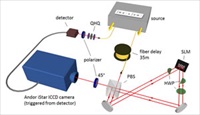Members Login

Channels
Special Offers & Promotions
Einstein's "Spooky Action at a Distance" shown for First Time in Real-Time Imaging
Ground-breaking speed and resolution of Andor iStar ICCD camera provides instantaneous visual evidence of quantum entanglement events for the first time.
 Quantum Entanglement is one of the most counterintuitive features of quantum mechanics, in which the quantum states of two physically separated particles are linked.
Quantum Entanglement is one of the most counterintuitive features of quantum mechanics, in which the quantum states of two physically separated particles are linked.
If a measurement is made that causes one particle of a pair to take on a definite value, the other particle will take the anti-correlated value instantaneously, even when separated by large distances.
Einstein called quantum entanglement "spooky action at a distance". Now, a team from the Vienna Center for Quantum Science and Technology has reported imaging of entanglement events where the influence of the measurement of one particle on its distant partner particle is directly visible.
The key to their success is the Andor iStar 334T Intensified CCD (ICCD) camera, which is capable of very fast (nanosecond) and precise (picosecond) optical gating speeds. Unlike the relatively long microsecond exposure times of CCD and EMCCD cameras which inhibits their usefulness in ultra-high-speed imaging, this supreme level of temporal resolution made it possible for the team to perform a real-time coincidence imaging of entanglement for the first time.
"The Andor iStar ICCD camera is fast enough, and sensitive enough, to image in real-time the effect of the measurement of one photon on its entangled partner," says Robert Fickler of the Institute for Quantum Optics and Quantum Information. "Using ICCD cameras to evaluate the number of photons from a registered intensity within a given region opens up new experimental possibilities to determine more efficiently the structure and properties of spatial modes from only single intensity images. Our results suggest that triggered ICCD cameras will advance quantum optics and quantum information experiments where complex structures of single photons need to be investigated with high spatio-temporal resolution."
According to Antoine Varagnat, Product Specialist at Andor, "The experiment produces pairs of photons which are entangled so as to have opposite polarisations. For instance, if one of a pair has horizontal polarisation, the other has vertical, and so on. The first photon is sent to polarising glass that transmits photons of one angle only, followed by a detector to register photons which make it through the glass. The other photon is delayed by a fibre, then its entangled property is coherently transferred from the polarisation to the spatial mode and afterwards brought to the high-speed, ultra-sensitive iStar camera.
"The use of the ICCD camera allowed the team to demonstrate the high flexibility of the setup in creating any desired spatial-mode entanglement. Their results suggest that visual imaging in quantum optics not only provides a better intuitive understanding of entanglement but will also improve applications of quantum science," concludes Varagnat.
Research into quantum entanglement was instigated in 1935 by Albert Einstein, Boris Podolsky and Nathan Rosen, in a paper critiquing quantum mechanics. Erwin Schrödinger also wrote several papers shortly afterwards. Although these first studies focused on the counterintuitive properties of entanglement with the aim of criticising quantum mechanics, entanglement was eventually verified experimentally and recognised as a valid, fundamental feature of quantum mechanics. Nowadays, the focus of the research has changed to its utilization in communications and computation, and has been used to realise quantum teleportation experimentally.
more about the iStar series of ICCD
Media Partners


